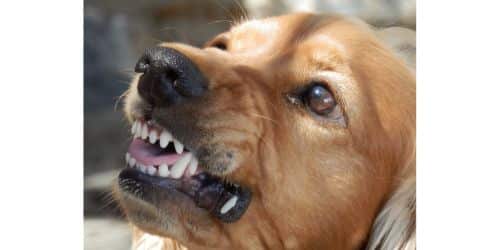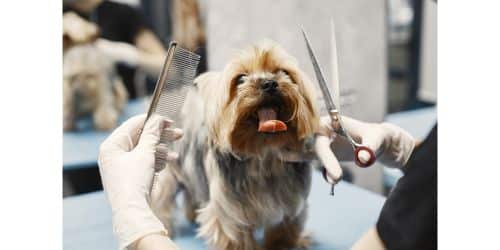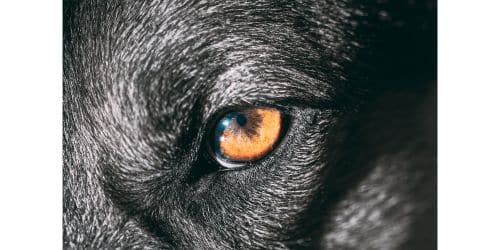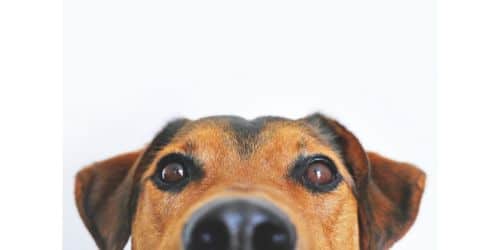When our pets get an eye ulcer, it may be a distressing and worrying time. The healing process, however, may begin with correct treatment and care, giving relief and restoration to your dog’s eye health. Recognizing the signs of a healing dog eye ulcer is critical for tracking development and ensuring your beloved pet is on the recovery path. In this detailed guide, we will look at the positive signs that a dog eye ulcer is healing, allowing you to provide the greatest care and support possible during this trip.
Signs a Dog Eye Ulcer Is Healing
When a dog gets an eye ulcer, it means that the cornea, the transparent outer layer of the eye, has been damaged. Eye ulcers can develop as a result of a variety of factors, including trauma, foreign objects, infection, or underlying health issues. The healing process includes corneal tissue regeneration, inflammation reduction, and infection avoidance. It is vital to remember that the healing duration will vary depending on the severity of the ulcer and the overall health of the dog.
It is critical to engage closely with your veterinarian during the recuperation time, following their recommended treatment plan and monitoring your dog’s progress. While healing happens, there are several encouraging signs to watch for that indicate your dog’s eye ulcer is healing. These signs can provide reassurance and aid in determining the efficacy of the treatment.
#1. Clearing the Haze: Better Vision
The improvement in vision is one of the most noticeable signs of a healing dog eye ulcer.
A dog with an eye ulcer may initially exhibit signs of vision impairment, such as squinting, bumping into things, or hesitating to navigate their environment. However, you may observe a gradual improvement in your dog’s vision ability while the ulcer heals. They may gain confidence in their movements, be able to manage obstacles more easily and respond appropriately to visual cues. This improvement in eyesight suggests that the ulcer is healing and the cornea is regaining transparency.
Examine your dog’s behavior throughout normal activities. It is a good sign that the eye ulcer is healing if you observe enhanced visual awareness, less bumping into furniture or walls, and higher accuracy in catching toys or rewards. However, keep in mind that full healing may take some time, and constant monitoring and follow-up with your veterinarian are essential.
#2. The Fading Redness: Reduced Inflammation
The progressive lowering of inflammation is another promising signs of a healing dog eye ulcer. Redness and swelling in the affected area are common signs of eye ulcers. As the ulcer heals, you may notice a reduction in redness and inflammation. The dilated and inflamed blood vessels that were present during the acute phase of the ulcer begin to normalize, resulting in a less red and irritated appearance. This good development implies that the cornea is healing and regaining its health.
Examine your dog’s eye gently to monitor the reduction of inflammation. Examine the surrounding tissue for any changes in color or texture. If the redness gradually fades and the eye appears calmer and less inflamed, this is a good sign that the ulcer is healing. However, some residual redness may continue even after the healing process, particularly in more severe cases. Consult your veterinarian for more information on what to expect during the recovery process.
#3. A Sparkle in the Eye: Improved Comfort
The improvement in your dog’s comfort level is one of the most pleasant signs of a healing dog eye ulcer.
Dogs often experience discomfort, agony, and heightened sensitivity to light during the acute phase of an eye ulcer. You may notice favorable changes in your dog’s behavior and general comfort levels while the ulcer heals. They may exhibit fewer indicators of pain, such as pawing at their eyes, rubbing excessively, or tearing excessively. Your dog may also become more light-sensitive and less likely to close or partially close their eyes. These changes show that the healing process is reducing their pain and restoring their overall well-being.
Keep a close eye on your dog’s behavior and any changes in his or her eye-related activities. If you notice less discomfort, increased light tolerance, and a more relaxed expression in your dog’s eyes, this is a good sign that the eye ulcer is healing. However, it is critical to be watchful and evaluate their comfort levels throughout their rehabilitation.
#4. The Art of Blinking: Normal Tear Production
The restoration of normal tear production is another signs of a healing dog eye ulcer.
Eye ulcers can disturb the tear film, which can result in decreased tear production and possible dryness. Tears serve an important part in eye health by providing lubrication and protection. You may notice an increase in your dog’s tear production as the ulcer heals. Their eyes may appear wet, and they may blink in a healthy, natural pattern. natural tear production suggests that the cornea is healing and that the eye is reverting to its natural state.
Examine the moisture level in your dog’s eyes to determine tear production. It is a good sign that the eye ulcer is healing if you see an increase in tear production, decreased dryness, and a natural blink rate. However, some dogs may require additional support in the form of artificial tears or prescribed medication to maintain appropriate tear production. Consult your veterinarian for advice on how to support tear film health during the healing process.
#5. Picture-Perfect Pupils: Normalized Size and Reaction
The size and movement of the pupils are important signs that a dog eye ulcer is healing.
The affected eye may have aberrant pupil size and/or response during the acute phase of an eye ulcer. Pupils may seem dilated or constricted, and light response may be slow or absent. The size and response of the pupils may return to normal when the ulcer heals. They should appear to be the same size in both eyes and should react quickly and properly to changes in light conditions. This positive development indicates that the eye ulcer is healing and that the eye’s general function is improving.
Examine your dog’s pupils under various lighting settings to determine their size and responsiveness. If you see that the pupils are all the same size and react quickly to changes in light, this is a sign of healing. However, keep in mind that pupil size and reactivity can be influenced by a variety of circumstances.
#6. The Vanishing Cloudiness: Improved Corneal Clarity
The improvement in corneal clarity signs that a dog eye ulcer is healing.
The existence of an eye ulcer frequently causes cloudiness or opacity of the cornea, affecting vision and impeding healing. However, you may observe a progressive increase in corneal clarity while the ulcer heals. The cloudiness may begin to fade, allowing for improved clarity and visibility through the cornea. This positive development suggests that the ulcer is healing and the damaged corneal tissue is renewing.
Examine your dog’s damaged eye carefully to determine corneal clarity. If you see a decrease in cloudiness and an increase in transparency, these are good signs that the dog eye ulcer is healing. However, it is crucial to note that complete corneal clarity restoration may take time, and some residual opacity may exist, particularly in more severe cases. Regular check-ins with your veterinarian will let you track your progress and ensure that all necessary steps are performed for optimal healing.
Putting the Puzzle Together: A Combination of Positive Signs
Keep in mind that the signs of a healing dog eye ulcer are interrelated and frequently appear together.
It’s important to recognize that the signs of a healing dog eye ulcer are not isolated but rather interlinked. The positive indicators discussed in the previous sections often manifest together, forming a comprehensive picture of healing. Your dog’s improved vision, reduced inflammation, increased comfort, normalized tear production, restored pupil size and reaction, and improved corneal clarity collectively signify that the eye ulcer is healing and the eye is regaining its health.
It is crucial to assess the combination of positive signs when you monitor your dog’s progress rather than focusing on a single symptom. Healing takes time, and the appearance of several positive indications encourages progress toward recovery. If you notice a convergence of these signs, it’s a good indicator that your dog eye ulcer is healing. However, if you have any concerns or uncertainties, always seek professional advice and comfort from your veterinarian.
The Time Factor: Patience and Follow-Up
Healing takes time, and patience is essential when monitoring the progress of a dog eye ulcer.
It is critical to remember that the healing procedure for a dog eye ulcer takes time. Depending on the severity of the ulcer and individual conditions, total recovery could take several weeks or even months. During this period, patience is key, as is adhering to your veterinarian’s recommended treatment plan, which includes any prescription drugs, follow-up appointments, and regular check-ups.
Consistent monitoring and follow-up visits with your veterinarian are required to ensure that your dog’s eye ulcer heals properly. Your veterinarian will thoroughly check your dog’s eye, assess progress, and make any required revisions to the treatment plan during these appointments. Additional tests or procedures may be performed to assess the healing process and manage any potential problems.
Celebrating Progress: The Importance of a Positive Outlook
Recognizing and praising the positive signs of a healing dog eye ulcer is not only good for your pet but also necessary for having a cheerful attitude throughout the process.
When dealing with a dog eye ulcer, it’s easy to get caught up in the difficulties and concerns that come with it. Recognizing and appreciating signs of healing, on the other hand, can improve your spirits and encourage to continue providing the greatest care for your furry buddy. Each positive indicator, whether it’s better vision, less inflammation, more comfort, normalized tear production, restored pupil size and responsiveness, or enhanced corneal clarity, represents a step ahead in the healing process.
Take the time to see how far your dog has come. Celebrate each milestone, no matter how minor, and acknowledge the time and work you’ve put into their care. Remember to compliment yourself for being a diligent and attentive pet owner. A positive attitude can have a significant impact on both you and your dog, creating an atmosphere of optimism, patience, and resilience.
How can you tell if dogs eye ulcer is getting better?
To track the healing phase, your veterinarian can do more fluorescein stain tests and assess the size of the ulcer. If observable symptoms such as redness, swelling, and tears start to fade, the corneal ulcer is likely healing.
What are the stages of eye ulcer healing?
The healing of a corneal epithelial incision can be split into phases that occur sequentially but may overlap in time. They are the latent or lag phase, migration, proliferation, and epithelial reattachment.
What does a healing ulcer look like in dogs eye?
Reduced redness and squinting are signs that a dog eye ulcer is healing, as is the dog’s general comfort level. Other symptoms that a dog eye ulcer is healing include the Third eyelid going back down. The eye no longer looks white.
How long does it take for an ulcer in a dog’s eye to heal?
Most corneal ulcers heal in a few days as the epithelium regenerates from the ulcer’s margins and extends over the defect. However, in some dogs, this healing process may not take place, and they go on to develop a SCCED.
What is the fastest way to heal an eye ulcer?
Antibiotic, antiviral, or antifungal eye drops are usually required right away and must be used regularly, often every hour around the clock for several days. Eye drops that dilate the pupil, such as atropine or scopolamine, can alleviate pain and lessen the likelihood of problems.
What happens if an eye ulcer doesn’t heal?
A corneal ulcer, if left untreated, can cause vision loss and perhaps blindness.
Can a dog still see with a corneal ulcer?
Corneal ulcers, if left untreated, can result in blindness. Corneal ulcers can cause the cornea to rupture, resulting in severe discomfort, infection, and, eventually, blindness. Early detection and treatment are critical for preventing further damage and restoring your dog’s vision.
Conclusion
The healing process of a dog eye ulcer can be difficult and uncertain, but identifying the signs of healing reassures you and allows you to accompany your furry companion on their road to recovery. Each beneficial symptom, from enhanced vision and reduced inflammation to increased comfort and normalized tear production, is evidence of the healing process in progress.
Remember to be patient, cooperate closely with your veterinarian, and keep a positive attitude throughout the recovery process. Your dog’s eye ulcer will heal with careful care and attention, restoring their ocular health and assuring a bright future together.
Related Articles
- DO DOGS GET HEMORRHOIDS? All You Need To Know
- DOG FEVER TREATMENT AT HOME: Signs and Causes
- SIGNS OF FLEAS ON CATS: Early Signs, Causes, And Treatment
- How To Treat A Limping Dog At Home
- Why Is My Cat Throwing Up Undigested Food?






